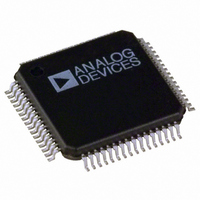ADE7166ASTZF8 Analog Devices Inc, ADE7166ASTZF8 Datasheet - Page 53

ADE7166ASTZF8
Manufacturer Part Number
ADE7166ASTZF8
Description
IC ENERGY METER 1PHASE 64LQFP
Manufacturer
Analog Devices Inc
Specifications of ADE7166ASTZF8
Applications
Energy Measurement
Core Processor
8052
Program Memory Type
FLASH (8 kB)
Controller Series
ADE71xx
Ram Size
512 x 8
Interface
I²C, SPI, UART
Number Of I /o
20
Voltage - Supply
3.135 V ~ 3.465 V
Operating Temperature
-40°C ~ 85°C
Mounting Type
Surface Mount
Package / Case
64-LQFP
Ic Function
Single Phase Energy Measurement IC
Supply Voltage Range
3.13V To 3.46V, 2.4V To 3.7V
Operating Temperature Range
-40°C To +85°C
Digital Ic Case Style
LQFP
No. Of Pins
64
Lead Free Status / RoHS Status
Lead free / RoHS Compliant
Available stocks
Company
Part Number
Manufacturer
Quantity
Price
Company:
Part Number:
ADE7166ASTZF8
Manufacturer:
Analog Devices Inc
Quantity:
10 000
Company:
Part Number:
ADE7166ASTZF8-RL
Manufacturer:
Analog Devices Inc
Quantity:
10 000
POWER QUALITY MEASUREMENTS
Zero-Crossing Detection
Each ADE7566/ADE7569/ADE7166/ADE7169 has a zero-
crossing detection circuit on the voltage channel. This zero
crossing is used to produce a zero-crossing internal signal (ZX)
and is used in calibration mode.
The zero-crossing is generated by default from the output of
LPF1. This filter has a low cut-off frequency and is intended for
50 Hz and 60 Hz systems. If needed, this filter can be disabled
to allow a higher frequency signal to be detected or to limit the
group delay of the detection. If the voltage input fundamental
frequency is below 60 Hz, and a time delay in ZX detection is
acceptable, it is recommended to enable LPF1. Enabling LPF1
limits the variability in the ZX detection by eliminating the high
frequency components. Figure 54 shows how the zero-crossing
signal is generated.
The zero-crossing signal ZX is generated from the output of
LPF1 (bypassed or not). LPF1 has a single pole at 63.7 Hz (at
MCLK = 4.096 MHz). As a result, there is a phase lag between
the analog input signal V2 and the output of LPF1. The phase
lag response of LPF1 results in a time delay of approximately
2 ms (@ 60 Hz) between the zero crossing on the analog inputs
of the voltage channel and ZX detection.
The zero-crossing detection also drives the ZX flag in the
Interrupt Status 3 SFR (MIRQSTH, 0xDE). If the ZX bit in the
Interrupt Enable 3 SFR (MIRQENH, 0xDB) is set, the 8052 core
has a pending ADE interrupt. The ADE interrupt stays active
until the ZX status bit is cleared (see the Energy Measurement
Interrupts section).
Zero-Crossing Timeout
The zero-crossing detection also has an associated timeout
register, ZXTOUT. This unsigned, 12-bit register is decremented
(1 LSB) every 160/MCLK seconds. The register is reset to its
user programmed, full-scale value every time a zero crossing is
detected on the voltage channel. The default power-on value in
V2
V
V
P
N
Figure 54. Zero-Crossing Detection on the Voltage Channel
PGA2
×1, ×2, ×4,
×8, ×16
0.73
{GAIN [7:5]}
1.0
V2
REFERENCE
43.24° @ 60Hz
ADC 2
LPF1
f
MODE 1[6]
–3dB
HPF
LPF1
= 63.7Hz
ZX
CROSS
ZERO
ZX
Rev. A | Page 53 of 144
this register is 0xFFF. If the internal register decrements to 0
before a zero crossing is detected in the Interrupt Status 3 SFR
(MIRQSTH, 0xDE), and the ZXTO bit in the Interrupt Enable 3
SFR (MIRQENH, 0xDB) is set, the 8052 core has a pending
ADE interrupt.
The ADE interrupt stays active until the ZXTO status bit is
cleared (see the Energy Measurement Interrupts section). The
ZXOUT register (Address 0x11) can be written to or read by the
user (see the Energy Measurement Register List section). The
resolution of the register is 160/MCLK seconds per LSB. Thus,
the maximum delay for an interrupt is 0.16 seconds (1/MCLK ×
2
Figure 55 shows the mechanism of the zero-crossing timeout
detection when the line voltage stays at a fixed dc level for more
than MCLK/160 × ZXTOUT seconds.
Period or Frequency Measurements
The ADE7566/ADE7569/ADE7166/ADE7169 provide the
period or frequency measurement of the line. The period or
frequency measurement is selected by clearing or setting the
FREQSEL bit in the MODE2 register (0x0C). The period/
frequency register, PER_FREQ Register (0x0A), is an unsigned
16-bit register that is updated every period. If LPF1 is enabled, a
settling time of 1.8 seconds is associated with this filter before
the measurement is stable.
When the period measurement is selected, the measurement has a
2.44 μs/LSB (4.096 MHz/10), which represents 0.014% when the
line frequency is 60 Hz. When the line frequency is 60 Hz, the value
of the period register is approximately 0d6827. The length of
the register enables the measurement of line frequencies as low
as 12.5 Hz. The period register is stable at ±1 LSB when the line
is established and the measurement does not change.
When the frequency measurement is selected, the measurement
has a 0.0625 Hz/LSB resolution when MCLK = 4.096 MHz,
which represents 0.104% when the line frequency is 60 Hz.
When the line frequency is 60 Hz, the value of the frequency
register is 0d960. The frequency register is stable at ±4 LSB when
the line is established and the measurement does not change.
12
REGISTER VALUE
) when MCLK = 4.096 MHz.
12-BIT INTERNAL
ADE7566/ADE7569/ADE7166/ADE7169
VOLTAGE
CHANNEL
ZXTOUT
ZXTO
FLAG
BIT
Figure 55. Zero-Crossing Timeout Detection













